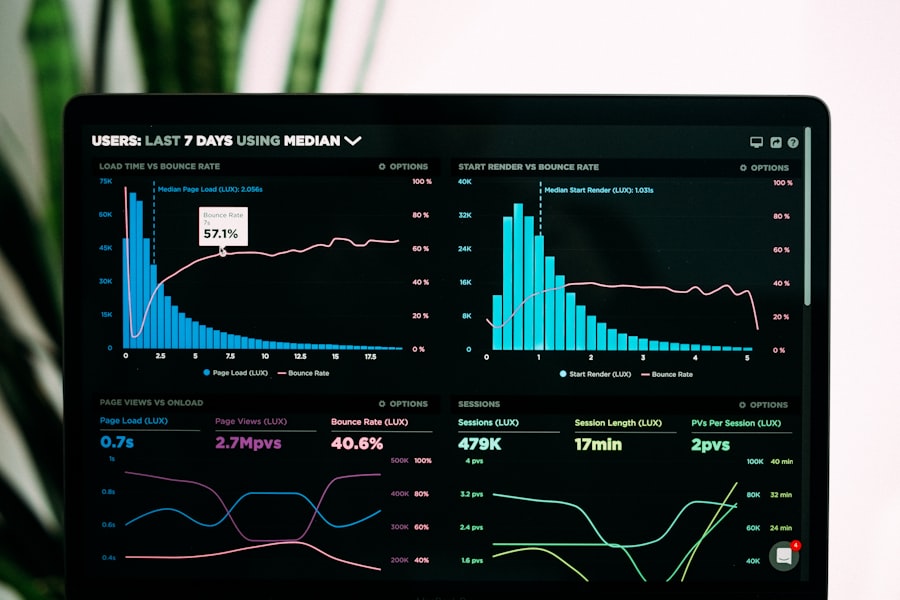In the rapidly evolving landscape of data analytics, Qlik stands out as a powerful tool that enables organizations to transform raw data into meaningful insights. Founded in 1993, Qlik has consistently pushed the boundaries of data visualization and analysis, offering a platform that empowers users to explore their data intuitively. With its unique associative model, Qlik allows users to navigate through vast datasets seamlessly, uncovering hidden relationships and patterns that traditional linear approaches often miss.
This capability not only enhances the user experience but also democratizes data access, making it available to a broader audience within organizations. Qlik’s flagship products, Qlik Sense and QlikView, provide robust solutions for data visualization and business intelligence. Qlik Sense, in particular, is designed with a focus on self-service analytics, enabling users to create their own reports and dashboards without relying heavily on IT departments.
This shift towards user empowerment is crucial in today’s data-driven world, where timely insights can significantly impact business outcomes. By leveraging Qlik’s advanced analytics capabilities, organizations can visualize complex data sets in a way that is both engaging and informative, fostering a culture of data literacy and informed decision-making.
Key Takeaways
- Qlik is a powerful tool for data analysis and visualization, enabling users to gain insights from their data.
- Self-service business intelligence (BI) empowers users to independently access and analyze data, leading to faster and more informed decision-making.
- Qlik facilitates collaboration by allowing users to easily share insights and discoveries with colleagues, fostering a culture of data-driven decision-making.
- By harnessing the potential of data, Qlik helps organizations turn information into actionable insights, driving business growth and success.
- Qlik plays a crucial role in driving informed decision-making by providing users with the tools and insights they need to make data-driven choices.
The Power of Self-Service Business Intelligence (BI)
Self-service business intelligence (BI) is revolutionizing the way organizations approach data analysis. With Qlik at the forefront of this movement, users are no longer passive consumers of reports generated by IT; instead, they become active participants in the data exploration process. This shift is particularly significant in an era where agility and responsiveness are paramount.
By empowering users to create their own analyses, Qlik enables organizations to respond swiftly to changing market conditions and emerging trends. The self-service capabilities of Qlik are underpinned by its intuitive interface and powerful analytics engine. Users can easily drag and drop elements to create visualizations that resonate with their specific needs.
This flexibility not only enhances user engagement but also encourages experimentation and innovation. As employees from various departments—be it marketing, finance, or operations—gAIn access to self-service BI tools, they can derive insights tailored to their unique challenges, ultimately driving better business outcomes.
Empowering Collaboration with Qlik: Sharing Insights and Discoveries

Collaboration is a cornerstone of effective decision-making in any organization, and Qlik excels in facilitating this process. The platform allows users to share insights and discoveries seamlessly across teams and departments. With features such as collaborative dashboards and storytelling capabilities, Qlik transforms data analysis from a solitary task into a collective endeavor.
This collaborative approach not only enhances the quality of insights but also fosters a culture of transparency and shared knowledge. Moreover, Qlik’s cloud-based solutions enable real-time collaboration, allowing teams to work together regardless of their physical location. Users can comment on specific data points, share visualizations, and even co-create reports in real time.
This level of interactivity ensures that everyone is on the same page, reducing the chances of miscommunication and aligning efforts towards common goals. As organizations increasingly embrace remote work and distributed teams, the collaborative features of Qlik become even more critical in maintaining cohesion and driving collective success.
Harnessing the Potential of Data with Qlik: Turning Information into Actionable Insights
| Metrics | Data |
|---|---|
| Number of Qlik users | 500 |
| Data sources connected | 10 |
| Percentage increase in data-driven decisions | 35% |
| Time saved on data analysis | 50% |
In today’s data-rich environment, the ability to turn information into actionable insights is a key differentiator for successful organizations. Qlik empowers users to harness the full potential of their data by providing advanced analytics capabilities that go beyond mere visualization.
The platform’s associative model plays a crucial role in this process by allowing users to explore data from multiple angles simultaneously. This multidimensional approach helps uncover correlations that might otherwise remain hidden in traditional reporting methods. By enabling users to ask questions and drill down into the data dynamically, Qlik fosters a deeper understanding of underlying factors driving business performance.
As a result, organizations can make informed decisions that are grounded in comprehensive data analysis rather than intuition alone.
The Role of Qlik in Driving Informed Decision Making
Informed decision-making is essential for any organization aiming to thrive in a competitive landscape. Qlik serves as a vital tool in this regard by providing decision-makers with the insights they need to make strategic choices confidently. The platform’s ability to aggregate data from various sources—be it internal databases or external APIs—ensures that users have a holistic view of their business environment.
This comprehensive perspective is crucial for identifying opportunities and mitigating risks. Furthermore, Qlik’s robust reporting capabilities allow organizations to track key performance indicators (KPIs) effectively. By visualizing KPIs in real time, decision-makers can monitor progress towards goals and adjust strategies as needed.
The ability to create customized dashboards tailored to specific roles within the organization ensures that relevant information is readily accessible to those who need it most. In this way, Qlik not only enhances individual decision-making but also aligns organizational efforts towards shared objectives.
Qlik’s Impact on Data-Driven Organizations: Case Studies and Success Stories

The impact of Qlik on data-driven organizations is evident through numerous case studies and success stories across various industries. For instance, a leading retail chain implemented Qlik to analyze customer purchasing behavior and optimize inventory management. By leveraging Qlik’s advanced analytics capabilities, the retailer was able to identify trends in consumer preferences, leading to more informed stocking decisions and ultimately increasing sales by 15%.
This case exemplifies how Qlik can drive tangible business results by transforming data into actionable strategies. Another compelling example comes from the healthcare sector, where a hospital network utilized Qlik to improve patient care outcomes. By analyzing patient data across multiple departments, the network identified bottlenecks in treatment processes and areas for improvement in patient flow.
As a result, they implemented targeted interventions that reduced patient wait times by 30% and improved overall satisfaction scores significantly. These success stories highlight not only the versatility of Qlik across different sectors but also its potential to drive meaningful change through data-driven insights.
The Future of Data Analysis and Visualization: Innovations and Trends in Qlik
As technology continues to advance at an unprecedented pace, the future of data analysis and visualization looks promising for platforms like Qlik. Innovations such as augmented analytics are set to redefine how users interact with data. By integrating artificial intelligence (AI) and machine learning capabilities into its platform, Qlik aims to automate routine tasks such as data preparation and anomaly detection.
This will allow users to focus more on interpreting insights rather than getting bogged down in technical details. Additionally, the trend towards increased personalization in analytics is gaining traction. Users will soon expect tailored experiences that cater specifically to their roles and preferences within an organization.
Qlik is already taking steps in this direction by enhancing its user interface and offering customizable dashboards that adapt based on user behavior. As these innovations unfold, organizations leveraging Qlik will be well-positioned to stay ahead of the curve in an increasingly competitive landscape.
Leveraging Qlik for Empowering Collaborative Insights and Business Growth
In conclusion, Qlik represents a transformative force in the realm of data analysis and visualization. Its commitment to self-service business intelligence empowers users across all levels of an organization to engage with data actively. By fostering collaboration and enabling informed decision-making, Qlik not only enhances individual performance but also drives collective success within teams.
As organizations continue to navigate an increasingly complex business environment, leveraging tools like Qlik will be essential for unlocking the full potential of their data assets. With its innovative features and focus on user empowerment, Qlik stands poised to lead the charge towards a future where data-driven insights are at the heart of every strategic decision. Embracing this technology will undoubtedly pave the way for enhanced collaboration, improved business outcomes, and sustained growth in an ever-evolving marketplace.
For those interested in the intersection of data analysis and emerging technologies, the article “Future Trends and Innovations in the Metaverse: Emerging Technologies Shaping the Metaverse” offers a fascinating exploration of how data integration and visualization are becoming increasingly crucial in the development of virtual environments. As Qlik focuses on Datenanalyse, Datenvisualisierung, Self-Service-BI, Datenintegration, and Collaborative Insights, understanding these future trends can provide valuable insights into how these tools can be applied within the evolving digital landscapes of the metaverse. You can read more about these insights and how they relate to the broader context of data-driven decision making in virtual spaces by visiting it/future-trends-and-innovations-in-the-metaverse-emerging-technologies-shaping-the-metaverse/’>Future Trends and Innovations in the Metaverse.
FAQs
What is Qlik?
Qlik is a software company that provides data analysis, data visualization, self-service business intelligence (BI), data integration, and collaborative insights solutions.
What are the key features of Qlik?
Qlik offers features such as data visualization, self-service data analysis, data integration from multiple sources, and collaborative insights through sharing and collaboration tools.
What is data visualization in Qlik?
Data visualization in Qlik refers to the process of presenting data in graphical or visual formats such as charts, graphs, and dashboards to make it easier for users to understand and analyze the data.
What is self-service BI in Qlik?
Self-service BI in Qlik allows users to access and analyze data without the need for IT or data experts. Users can create their own reports, dashboards, and visualizations using intuitive tools and interfaces.
What is data integration in Qlik?
Data integration in Qlik involves the process of combining data from multiple sources such as databases, spreadsheets, and cloud applications to create a unified view of the data for analysis and visualization.
What are collaborative insights in Qlik?
Collaborative insights in Qlik enable users to share and collaborate on data analysis, visualizations, and reports with colleagues, allowing for better decision-making and insights across teams and departments.











Leave a Reply